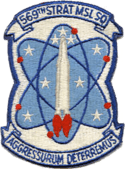569th Strategic Missile Squadron
| 569th Strategic Missile Squadron | |
|---|---|
|
First successful launch of an SM-68 Titan I ICBM at Cape Canaveral, Florida on 10 August 1960 at the Atlantic Missile Range | |
| Active | 1942-1945; 1962-1965 |
| Country |
|
| Branch |
|
| Type | Squadron |
| Role | Intercontinental ballistic missile |
| Garrison/HQ | Mountain Home Air Force Base, Idaho |
| Engagements |
World War II (EAME Theater) |
| Decorations |
Distinguished Unit Citation |
| Insignia | |
| 569th Strategic Missile Squadron emblem |
 |

The 569th Strategic Missile Squadron (567 SMS) is an inactive United States Air Force unit. It was last assigned to the 9th Strategic Aerospace Wing, stationed at Mountain Home AFB, Idaho
On 1 June 1961, the 569th Strategic Missile Squadron (ICBM-Titan) went on alert status as a Strategic Air Command (SAC) Intercontinental ballistic missile (ICBM) squadron, being equipped with the first-generation SM-68 Titan I, with a mission of nuclear deterrence.
The squadron was inactivated as part of the phaseout of the Titan I ICBM on 31 July 1964
History
World War II
Activated in early 1943 as a B-17 Flying Fortress heavy bomber squadron, it trained under the Second Air Force. It deployed to England in the European Theater of Operations (ETO) during July 1943 where it was assigned to VIII Bomber Command as a strategic bombardment squadron. It participated in the air offensive over Nazi Germany and Occupied Europe until the German capitulation in May 1945. Squadron personnel were demobilized in England and returned to the United States; the squadron was reassigned to the Second Air Force and was planned to be re-equipped with B-29 Superfortresses for deployment to the Pacific Theater. The Japanese capitulation led to the units' inactivation in August 1945, being neither manned or equipped.
It was re-activated in the postwar Air Force Reserve as a B-29 squadron in 1947 and inactivated due to budget reductions in 1949.
Intercontinental Ballistic Missile Squadron
It was re-activated once more in 1961 as a HGM-25A Titan I ICBM launch squadron, the last such activation of a Titan I squadron within the Strategic Air Command. The squadron was deployed in a 3x3 configuration, which meant a total of nine missiles were divided into three bases. Each base had three ICBMs ready to launch at any given time.
On 19 November 1964, Defense Secretary Robert McNamara announced the phasing-out of the remaining first-generation SM-65 Atlas and Titan I missiles by the end of June 1965. Consequently, the Titan Is of the 569th SMS were removed from alert status on 17 February 1965. The last missile was shipped out on 1 April. The US Air Force subsequently inactivated the squadron.
Missile sites were later sold off to private ownership after demilitarization. Today the remains of the sites are still visible in aerial imagery, in various states of use or abandonment.
Lineage

- Constituted as the 569th Bombardment Squadron (Heavy) on 15 January 1943
- Activated on 26 January 1943
- Inactivated on 28 August 1945
- Re-designated as the 569th Bombardment Squadron (Very Heavy) on 3 July 1947
- Activated in the reserve on 24 June 1947
- Inactivated on 27 June 1949
- Re-designated as the 569th Strategic Missile Squadron and activated on 12 December 1960
- Organized on 1 June 1961
- Inactivated on 1 April 1965
Assignments
- 390th Bombardment Group, 26 January 1943 – 28 August 1945
- Second Air Force, 24 July 1947
- Tenth Air Force, 1 Ju1 1948-27 June 1949
- Strategic Air Command, 12 December 1960
- 9th Bombardment (later Strategic Aerospace) Wing, 1 June 1961 – 31 July 1984
Stations
- Geiger Field, Washington, 26 January 1943
- Great Falls Army Air Base, Montana, 6 June-4 July 1943
- RAF Framlingham (AAF-153), England, 26 July 1943 – 6 August 1945
- Sioux Falls Army Air Field, South Dakota, 14–28 August 1945
- Lowry Field, Colorado, 24 July 1947 – 27 June 1949
- Mountain Home AFB, Idaho, 1 May 1962 – 31 July 1984
Aircraft and missiles

- B-17 Flying Fortress, 1943–1945
- B-29 Superfortress, 1947–1949
- SM-68 Titan I Missile 1962-1964
- Operated three missile sites: (1 Jun 1961-25 Jun 1965)
- 569-A, 12 miles SW of Hot Springs, Idaho 42°40′14″N 115°52′02″W / 42.67056°N 115.86722°W
- 569-B, 7 miles E of Oreana, Idaho 43°03′58″N 116°15′50″W / 43.06611°N 116.26389°W
- 569-C, 3 miles NE of Orchard, Idaho 43°20′42″N 115°59′33″W / 43.34500°N 115.99250°W
See also
References
![]() This article incorporates public domain material from the Air Force Historical Research Agency website http://www.afhra.af.mil/.
This article incorporates public domain material from the Air Force Historical Research Agency website http://www.afhra.af.mil/.
- Maurer, Maurer, ed. (1983) [1961]. Air Force Combat Units of World War II (PDF) (reprint ed.). Washington, DC: Office of Air Force History. ISBN 0-912799-02-1. LCCN 61060979.
- Maurer, Maurer, ed. (1982) [1969]. Combat Squadrons of the Air Force, World War II (PDF) (reprint ed.). Washington, DC: Office of Air Force History. ISBN 0-405-12194-6. LCCN 70605402. OCLC 72556.


